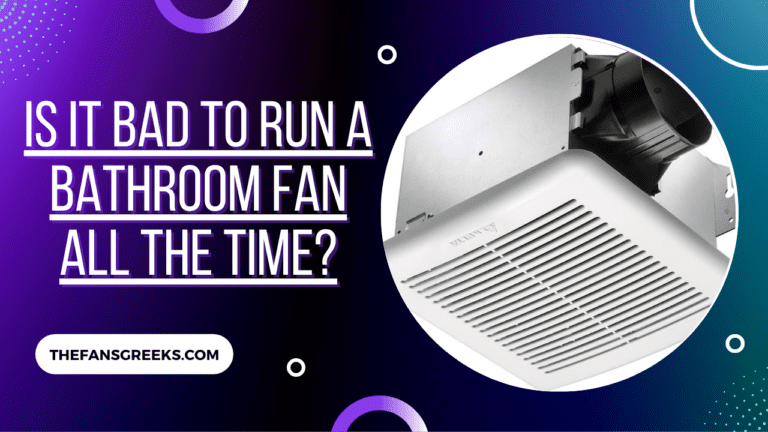How To Fix A Noisy Bathroom Fan?
You’ve come to the right place if you have a noisy bathroom exhaust fan.
Several factors may cause an appliance of this type to become louder than it should be, but it’s usually one of the most common. I’ll go over each one in more detail.

The following topics will be covered in this guide:
- Checking the vent duct;
- Oiling the wick bearings;
- Cleaning the grille cover;
…and more. Let’s get started!
The Introduction
One of the most common complaints among new homeowners is an excessively noisy bathroom exhaust fan.
In particular, this is true for those who own “builder-grade” bath fans, which are cheap and not so good quality.
These units are not only louder than their premium-quality counterparts, but they also tend to become even louder over time.
A loud appliance of this type may develop several issues with age. There is a possibility that the duct will impede the model’s airflow, or the grille may become clogged with dust.
Additionally, the fan’s blades can misalign and its engine may lose lubrication.
All of these problems can make a bathroom exhaust fan very loud. Here’s how you can fix all of them:
Step #1 – Dirty Grille Cover
As someone who knows a thing or two about bathroom exhaust fans, I have seen dirty or clogged grille covers many times in my life.
Typically, people don’t realize that a dirty grille cover on a bathroom exhaust can cause a fire.
Overheating is much more likely to occur with a dirty fan than with a clean, well-maintained one.
Most bathroom exhaust fans only have a grille cover that is actually visible. All sorts of debris and dirt can easily accumulate on these beige or plain white covers.
It is unfortunate that most homeowners don’t bother to clean their bath fan grille covers, despite the fact that it is extremely easy and takes only a few minutes.
Bathroom exhaust fans can be extremely noisy if their grille covers are grimy.
As a result of the greasy cover, the fan will start making strange noises because there is not enough air being drawn into the appliance.
You can resolve this issue by removing the cover, rinsing it thoroughly, and then reattaching it once it has dried.
Step #2 – Dried-Out Engine Bearings
Oil wick bearings are typically found in older models of bathroom exhaust fans.
These oil wick bearings are supposed to be lubricated periodically with some light engine oil by those who own such bath fans.
In most cases, people do not clean grille covers.
Whether a fan’s motor runs smoothly depends on the condition of these bearings.
Without the aforementioned engine oil, the bearings will go dry and cause serious problems for the motor.
Fan motors that run rough will be much noisier than those that run smoothly.
Several months ago, I oiled one of those popular Broan-NuTone bathroom exhaust fans, and it made a huge difference in terms of noise. Furthermore, oiling also improved the fan’s efficiency and smoothness.
Oiling the wick bearings requires completely removing the exhaust fan motor and then uninstalling the bearing brackets.
The oil that needs to be oiled can be almost any kind of light engine oil – just apply a few drops to each part.
Step #3 – Fan Blade Misalignment
You should also check the fan’s blades and make sure they’re spinning correctly when removing the engine of the exhaust fan to oil it.
This may be the reason why your bathroom exhaust fan is making so much noise while running if one of the blades is “wobbly” while spinning or if it’s hitting something while running.
When you spin the blades with your hand, check to see if they’re spinning smooth and balanced – if they’re not, you’ll probably need to replace them.
Step #4 – Too Many Duct Bends
Another issue that can cause a bathroom exhaust fan to produce too much noise is too many duct bends.
The amount of air resistance is determined by each duct bend. Noise will also increase if there’s too much air resistance.
A fan duct should not have more than three bends and no 90-degree turns in an ideal situation.
The bends must be smooth and gradual in order to maximize airflow (and reduce noise).
It is particularly effective to reduce exhaust fan noise by using metal ducting instead of flexible ducting.
An exhaust fan’s overall noise level is heavily influenced by the ridges inside flexible ducts, which, as mentioned above, are prone to creating air resistance.
Step #5 – Clogged Duct
There’s no doubt that birds love to nest inside dryer vent ducts and bathroom vent ducts.
Airflow can be completely halted by a bird’s nest, as you might have already guessed.
As a result, not only will the fan produce more noise, but its performance will also be negatively affected.
Simply turning on the appliance and checking outside for airflow is the easiest way to determine whether there is adequate airflow in the duct.
There should be a flapper on the cover of the vent, which opens when the exhaust fan operates.
Obviously, if the flapper isn’t open, there’s not enough airflow in the duct, resulting in clogs.
Step #6 – The Duct is Too Small
Modern bathroom exhaust fans require larger ducting than older models, which used 3″ ducts.
The duct you need for this type of appliance to work properly is likely to be 4-6″ wide if you just bought one.
Your new bathroom exhaust fan will be less efficient and noisier if you use an undersized duct.
The Takeaway
A bathroom exhaust fan can be noisy and rackety for a variety of reasons, and most of them are easy to fix.
My recommendation is to just buy a new model, preferably one of the best-rated quiet bathroom exhaust fans, if the problem persists no matter what you do, i.e. if cleaning and oiling don’t solve the problem.
![Bathroom Fan Stopped Working (Won’t Turn On) [FIXED]](https://www.thefansgreeks.com/wp-content/uploads/2022/08/Bathroom-Fan-Stopped-Working-Wont-Turn-On-FIXED-768x432.png)




